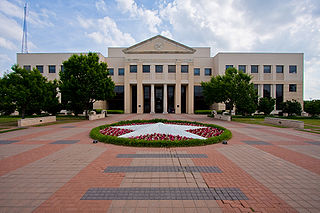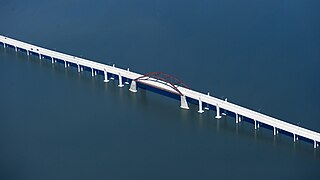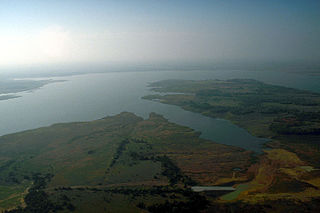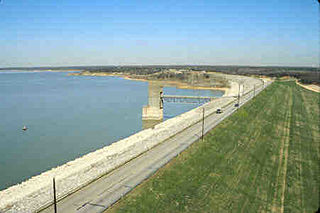
Denton County is located in the U.S. state of Texas. As of the 2020 census, its population was 906,422, making it the seventh-most populous county in Texas. The county seat is Denton. The county, which was named for John B. Denton, was established in 1846. Denton County constitutes part of the Dallas–Fort Worth metroplex. In 2007, it was one of the fastest-growing counties in the United States.

Lake Dallas is a city in Denton County, Texas, United States. It is located in North Texas, northwest of the city of Dallas, on the shores of Lewisville Lake. The community's name derives from the original name of the lake. It is also one of the four communities in the Lake Cities.

Little Elm is a city in Denton County, Texas, United States, and a part of the Dallas–Fort Worth metroplex. It is an extended suburb of Denton; its population was 46,453 as of the 2020 census. In 2000, the census population was at 3,646. By the 2010 census, the city total had jumped to 25,898, making Little Elm one of the fastest-growing municipalities by percentage in Texas since 2000. The July 1, 2022 census estimates Little Elm's population as 55,357.

Lewisville is a city in the U.S. state of Texas, located in Denton County with portions extending into Dallas County. As one of the Mid-Cities within the Dallas–Fort Worth metroplex, the 2020 census reported a population of 111,822.

Lake Travis is a reservoir on the Colorado River in central Texas in the United States. It is named in honor of William B. Travis.

The Trinity River is a 710-mile (1,140 km) river, the longest with a watershed entirely within the U.S. state of Texas. It rises in extreme northern Texas, a few miles south of the Red River. The headwaters are separated by the high bluffs on the southern side of the Red River.

Table Rock Lake is an artificial lake or reservoir in the Ozarks of southwestern Missouri and northwestern Arkansas in the United States. Designed, built and operated by the U.S. Army Corps of Engineers, the lake is impounded by Table Rock Dam, which was constructed from 1954 to 1958 on the White River.

The Lewisville Lake Toll Bridge (LLTB) is a 1.7-mile (2.7 km) tied arch bridge crossing Lewisville Lake in Denton County, Texas, USA. Operated by North Texas Tollway Authority (NTTA), the four-lane toll bridge connects Swisher Road in Lake Dallas to Eldorado Parkway in Little Elm. It is one segment of the 13-mile (21 km) Lewisville Lake Corridor, which connects Interstate 35E and Dallas North Tollway.

Summersville Lake is a reservoir located in the US state of West Virginia. The lake is formed by a rock-fill dam on the Gauley River, south of Summersville in Nicholas County. It is the largest lake in West Virginia, with 2,700 acres (1,100 ha) of water and over 60 miles (97 km) of shoreline at the summer pool water level. Its maximum depth is 327 feet. Part of the northern shore of the lake is managed by the West Virginia State Park system.

Canyon Lake is a reservoir on the Guadalupe River in the Texas Hill Country in the United States. Canyon Lake is a U.S. Army Corps of Engineers reservoir formed on the Guadalupe River in Comal County by Canyon Dam, which is located about sixteen miles northwest of New Braunfels. The dam, lake, and all adjacent property are managed by the U.S. Army Corps Of Engineers. Water rights, waste water treatment, and hydroelectric generating facilities are managed by the Guadalupe-Blanco River Authority. Construction of the dam began in 1958 and was completed in 1964. The reservoir serves to provide flood control and water supply for the communities downstream from the dam. The lake is also a popular recreational destination.

Lake Ray Roberts is an artificial 29,350-acre (119 km2) American reservoir located 10 miles (20 km) north of Denton, Texas, between the cities of Pilot Point, Texas and Sanger, Texas. It is filled by a tributary of the Trinity River.

Wright Patman Lake is a reservoir in northeast Texas in the United States. The lake is a U.S. Army Corps of Engineers reservoir formed on the Sulphur River in Bowie and Cass counties by Wright Patman Dam. The reservoir provides flood control and water conservation for the communities downstream from the dam. The lake is also a popular recreational destination. The Bowie County side of the lake is part of the Texarkana metropolitan area.

Eagle Mountain Lake is a reservoir in North Texas, formed by the damming the West Fork of the Trinity River. The reservoir sits below Lake Bridgeport reservoir and above Lake Worth reservoir.

Lavon Lake is a freshwater reservoir located in southeast Collin County, Texas, on the East Fork of the Trinity River near Wylie, off State Highway 78. It is commonly called Lake Lavon for commercial and recreational purposes, but Lavon Lake is its official name according to the U.S. Army Corps of Engineers. It was originally called Lavon Reservoir.

Grapevine Lake is a reservoir in North Texas about 20 mi (32 km) northwest of Dallas and northeast of Fort Worth. It was impounded in 1952 by the U.S. Army Corps of Engineers when they dammed Denton Creek, a tributary of Trinity River.

Lake O’ the Pines is a reservoir on Big Cypress Bayou, also known as Big Cypress Creek, chiefly in Marion County, Texas, USA. The reservoir also occupies a small part of Upshur and Morris Counties. The dam is located approximately 8.5 miles (13.7 km) west of Jefferson.

Benbrook Lake is a reservoir on the Clear Fork of the Trinity River in Tarrant County, Texas, USA. The lake is located approximately 10 miles (16 km) southwest of the center of Fort Worth, where the Clear Fork and the West Fork of the Trinity River join. The lake is impounded by the Benbrook Dam. The lake and dam are owned and operated by the U.S. Army Corps of Engineers, Fort Worth District.

The A-train is a hybrid rail service in Denton County, Texas, United States. The service is operated by Rio Grande Pacific under the authority of the Denton County Transportation Authority (DCTA).

Highland Village/Lewisville Lake station is an A-train commuter rail station in Lewisville, Texas. It is operated by the Denton County Transportation Authority (DCTA).






















